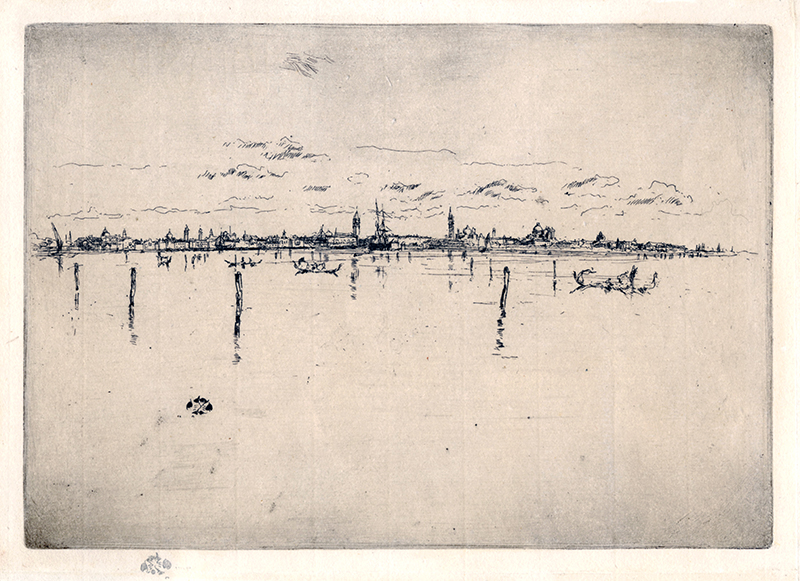The Little Venice is an etching created in 1880 by James Abbott McNeill Whistler. It is pencil signed with the butterfly beneath the platemark in the lower left margin. The references are Glasgow 238, Kennedy 183, Mansfield 180, and Wedmore 149, and this is state ii/ii. The Little Venice was printed by the artist in black ink on antique, ivory laid paper with a large coast of arms watermark. Glasgow notes that most impressions were in the second state, as printed for the Fine Art Society. The Little Venice is from The First Venice Set. The platemark measures 7-1/4 x 10-5/16 inches.
According to James McNeill Whistler: The Etchings A Catalogue Raisonné, “Venice, a Series of Twelve Etchings (The First Venice Set) was commissioned by the Fine Art Society, London. The set was exhibited and published in 1880.” According to the printing records for his work archived at Glasgow, there are fifty-four known impressions from two states.
James Abbott McNeill Whistler, painter and printmaker, was born in Lowell, Massachusetts on July 11, 1834. At the age of nine years old, Whistler and his family moved to Russia where he received his first drawing lessons at the St. Petersburg Academy in 1845. On the death of his father in 1849, the family returned to America.
In 1851, Whistler entered the United States Military Academy at West Point but during his three year stint as a cadet, he proved to be anything but military material and was dismissed from the academy by Colonel Robert E. Lee. Traveling to Paris, Whistler entered the studio of Charles Gleyre in 1856. While in Paris he was introduced to Fantin-Latour and Gustave Courbet. Upon his rejection by the Salon in 1859, Whistler left Paris for London.
Toward the end of the 1860s, Whistler produced the first of his painted nocturnes. These paintings were intended to capture the poetic mood of pictorial and musical harmony and this theme was to hold his attention for nearly a decade. From the 1870s he increasingly turned to painting portraits, which formed his major source of income until the late 1800s. In 1878, Whistler sued leading art critic Ruskin for libel, and despite winning a moral victory, was driven into bankruptcy by the cost of the action. However, this did not deter the artist, and he would grow rapidly in talent and fame soon enough.
As a printmaker, Whistler probably had more influence on the international scene than any one person since Rembrandt. His contributions to the fine art of lithography paved the way to the medium that became important in the 20th century. However, it was as an etcher that Whistler had his greatest influence: he created etchings and drypoints in basically four concentrations of activity: 1858-61 (The French Set), 1870-75 (The Thames Set), 1877-80 (the two Venice sets), and 1884-89 (London, France, Brussels, and Amsterdam).
Whistler usually worked directly on his plates, seeking out subject matter and locations that others would avoid: the waterfront, back alleys, courtyards, ordinary shops, and people engaged in daily activities. He used dental tools to draw on the grounded plates he would carry with him. Whistler etched his own plates, often holding them in his hand while using a feather to coax the acid across the surface and letting his experience and instinct guide him. Although he used professional printers such as Auguste Delâtre and Goulding for the editioned prints, he became increasingly dissatisfied with the results and, by the time he started printing the First Venice Set, he began printing all proofs himself, signing with the butterfly on a tab left on the lower margin (though later he did use hand-picked assistants to finish the First Venice Set which had gotten years behind schedule).
Whistler learned much about etching from Auguste Delâtre, who printed The French Set for the Fine Art Society. Delâtre taught him the importance using of quality antique papers, even for proving, something Whistler did the rest of his life. He also taught Whistler the technique of retroussage, a technique that Delâtre had used to achieve the chiaroscuro while reprinting Rembrandt’s plates. This involved leaving a thin film of ink after wiping the plate to achieve an atmospheric effect. Whistler used this very effectively to create the extraordinary impressions of both Venice sets. The amount of ink left, the amount of color added to the ink and the color of the paper combined to make each print unique, even changing the time of day from morning to evening.
Whistler was the president of the Society of British Artists from 1886 to 1888 and, in 1892, the Goupil Gallery in London arranged a successful solo exhibition of his work. Whistler's aesthetic approach found expression in the subtle effect of delicate colors and tone values, his portraits, landscapes, and interiors exercising great charm. His manner of painting owes less to the analytical technique of Impressionism but rather more to the color impressionism developed in the 17th century.
James Abbott McNeill Whistler died in London on July 17, 1903.



